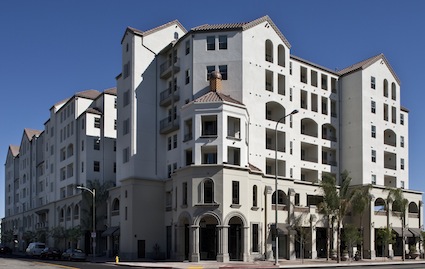Luxury Meets Green Living at USC

The new 161-unit private student apartment building at USC is designed for both sustainability and luxury.
LOS ANGELES — A new eco-friendly 161-unit student housing apartment building opened in May at the University of Southern California (USC), designed to balance “exceptional amenities” with sustainability.
West 27th Place, located at the major cross street of Figueroa, is registered with the U.S. Green Building Council and aims to achieve LEED Platinum, according to officials from Symphony Development, the project’s builder. If certified, West 27th Place would be one of only four Platinum-certified developments in Los Angeles and the only residential project achieving this milestone, according to officials from the development company.
The apartment building will also include 10,000 square feet of shops and restaurants.
“One item after another was analyzed and designed to deliver dual benefits: to suit the needs of tenants and also to be enviro-friendly,” said Symphony Development President David Hilliard. “We performed this analysis literally on every single component of the building, from windows to insulation to even our elevator, which is a high-speed OTIS unit that actually generates electricity on its down cycle and returns electricity to the grid.”
Hilliard said at the time of development, the city was offering expedited planning approvals for projects that registered for any green certification. The developers analyzed ways to incorporate green components and while they initially aimed for LEED Silver, they found that careful selection of materials and construction techniques could lead to additional points at a relatively small increase in cost.
In addition to the push from the city, students using social media outlets also expressed their interest in green measures. Currently, no other housing at the campus has any level of LEED certification.
“The green element is very important to USC students,” Hilliard said. “We have numerous persons that their lease decision was wholly based on us being green and they have also been very passionate about this on our Facebook page.”
John Mavar, Symphony’s director of construction, said their research found most students had already adopted a more green lifestyle and would be more inclined to choose an eco-friendly building as their preferred housing choice.
Online Presence
Hilliard said that prospective student tenants have expressed interest in the units through the company’s Facebook and Twitter pages.
“I think most student housing management companies use Facebook and Twitter all the time, but it’s particularly useful for communicating with prospective students about marketing issues and the unique aspects of the building,” he said. “It’s also good with new buildings to learn the different preferences the students want.” Input received ranged from furniture, parking spot and laundry preferences, as well as concerns.
“We use it to generate a line of communication with our prospective residents, no matter where they are in the process — whether they’re just potential tenants or actual future tenants — and we need information from them about how they want their space to look,” Hilliard said.
Hilliard said most people who comment have more than a passing interest in the building. “Usually they don’t get too active on the social media sites till they’re already part of the community,” he said.
That isn’t always the case, though, since prospective tenants may spend a lot of time reviewing the comments of others who already have signed leases, officials said. “From an owner’s point of a view, it certainly forces us to stay on our toes. If people are not happy, they’re not shy about saying what’s wrong,” Hilliard said.
Sustainable Living
Mavar said the sustainable features would result in reduced costs compared to a conventionally built counterpart structure and lead to a longer life expectancy for the building.
Like in much of real estate, the sustainable features of the building began with the location. The project is situated near multiple community resources and ample public transportation, including a stop near the university’s bus line, he said. Additionally, the parking garage assigns preferred spaces for low-emitting and fuel-efficient vehicles, along with bicycle storage.
“West 27th Place is student housing, but with amenities you might expect in a first-class apartment building,” Hilliard said. “There are some luxury items that may, at face value, seem incompatible with sustainable development. But what we’ve found is that austerity does not necessarily represent eco-friendly construction.”
Officials said they used finishes in the common areas and interiors that are designed to last a long time, and flooring in both the laminated hardwood and carpeted areas are made of recycled materials.
A saltwater swimming pool and spa uses fewer chemicals than a conventional pool, and the building’s 24-hour fitness center and computer lab are designed with recycled materials in their furnishing and floor coverings.
“We just went the extra yard to deliver a higher quality,” he said.
Quality Housing Facility
Pricing ranges from $850 to $1,000, monthly per bed, and each unit comes with a new refrigerator and 42-inch flat screen television. Each unit features nine-foot ceilings and a walk-in closet, and kitchens boast granite slab countertops and all Energy Star appliances.
Although both sustainability and student comfort were top priorities, the ultimate goal was to create a new apartment complex that would fit the USC student community.
“We feel our desire to provide a new, eco-friendly, compatible lifestyle for the students of USC has been achieved,” Hilliard said.
